Beyond the harp, discover the unexpected array of instruments King David played in the Bible, from lyres to shofars, in this revealing exploration.
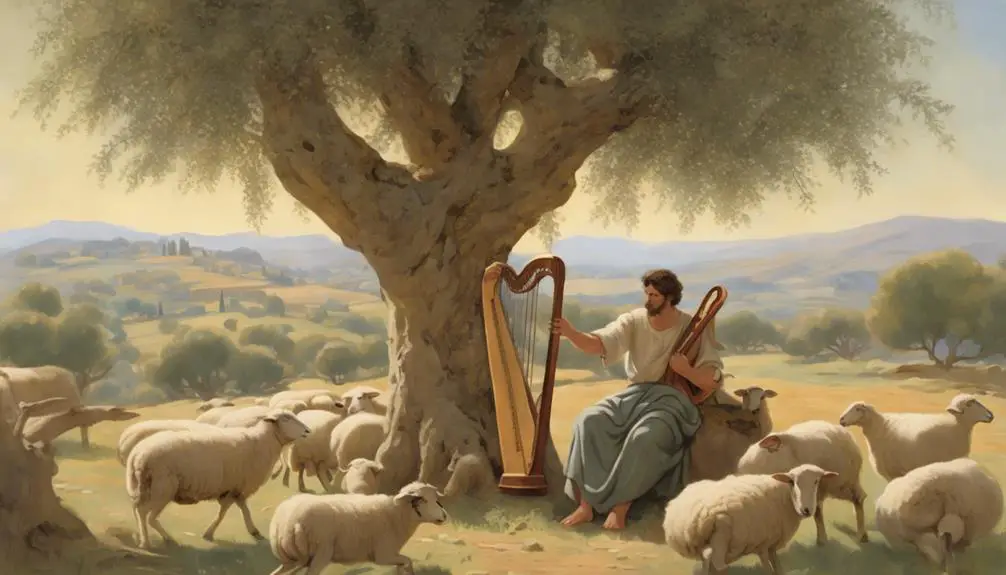
What Instruments Did David Play in the Bible
It seems King David could've single-handedly filled an entire orchestra with the array of instruments he's credited with playing in the Bible. You're likely familiar with his renowned skills on the harp, but did you know that his musical repertoire extended far beyond this single instrument?
From lyres that echoed through the corridors of his palace to the solemn blasts of the shofar that called his people to worship, David's musical talents were as varied as they were profound. If you're curious about the lesser-known instruments that accompanied his psalms and celebrations, you're in for a fascinating exploration.
Key Takeaways
- David played the harp, lyre, and nevel, showcasing his refined musical skills.
- These string instruments were vital in religious ceremonies and royal courts.
- Emotional storytelling and connection were central to David's use of these instruments.
- Mastery of the harp, lyre, and nevel highlighted David's significant musical legacy.
The Harp: David's Signature
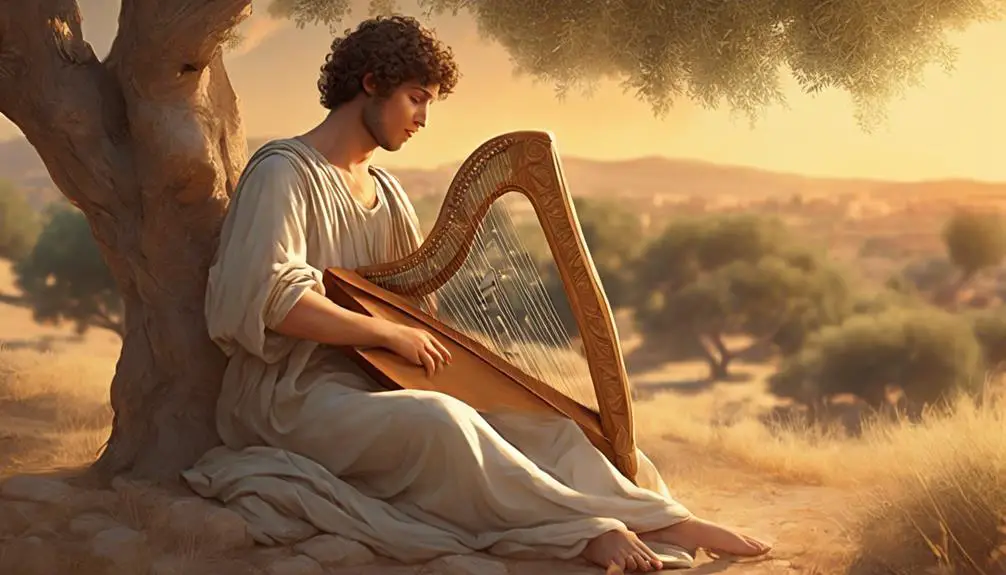
David's mastery of the harp, a stringed instrument revered for its melodious sounds, significantly marked his early life and royal legacy. You must understand, the harp's construction and the musical training essential for mastering it, both played pivotal roles in David's journey from a shepherd boy to a revered king and musician. The harp, with its intricately designed framework and carefully strung chords, required not only a deep understanding of its construction but also a refined skill set that David honed over years.
As you delve deeper, it's evident that the harp's construction, often crafted from fine woods and strung with durable materials, was a testament to the artisan's skill and the musician's dedication. David's proficiency suggests an intimate knowledge of the instrument, highlighting the significance of harp construction in his musical training. His ability to produce such profound, soothing melodies that reportedly calmed King Saul's troubled spirit, underscores the harp's role in therapeutic and ceremonial settings, further amplifying its importance in David's life.
Moreover, David's musical training, likely self-taught in the pastoral settings of his youth, speaks volumes about his dedication and natural talent. The harp, being central to his musical endeavors, required a nuanced mastery that went beyond mere technical skill. It demanded an emotional connection, allowing the player to convey feelings and stories through the strings. This aspect of David's musical training, particularly with the harp, not only showcases his exceptional talent but also cements the harp's symbolic significance in his spiritual and royal narratives.
Lyres Beyond the Harp
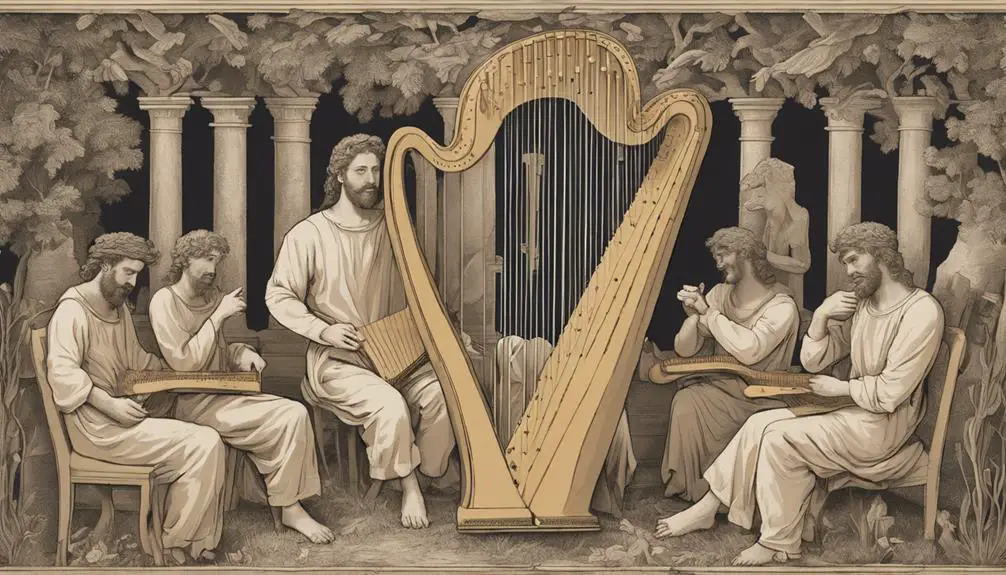
While the harp stands out as a foundational element in David's musical repertoire, his mastery extended to the lyre, a closely related instrument that also played a significant role in biblical times. You'll find that the lyre, with its distinct construction and tuning methods, offers a fascinating glimpse into ancient music-making.
Lyre construction in David's era was a meticulous process, reflecting the instrument's cultural significance. Crafted from quality woods, the lyre's frame typically featured a U-shape or a circular body, distinguishing it from the harp's more open design. Animal skin or gut formed the resonating surface, stretched across the frame, while strings—made from gut, animal sinew, or even plant fibers—were tightly affixed. This construction not only produced a rich, melodious sound but also demonstrated the artisanal skill and aesthetic considerations of the time.
Ancient tuning methods reveal further sophistication. Tuning the lyre required an acute ear and knowledge of musical theory far beyond simple craftsmanship. Musicians would adjust the tension of each string to achieve the desired pitch, a task that necessitated an understanding of the relationship between string length, tension, and pitch. This process, likely passed down through generations, underscores the depth of musical knowledge and tradition in David's time.
Analyzing the lyre's place in biblical history not only broadens our appreciation for its music but also offers insights into the cultural and technological advancements of ancient societies. David's prowess with the lyre, therefore, wasn't merely a testament to his personal talent but a reflection of a rich musical tradition that he both inherited and contributed to.
The Nevel: A Biblical Harp
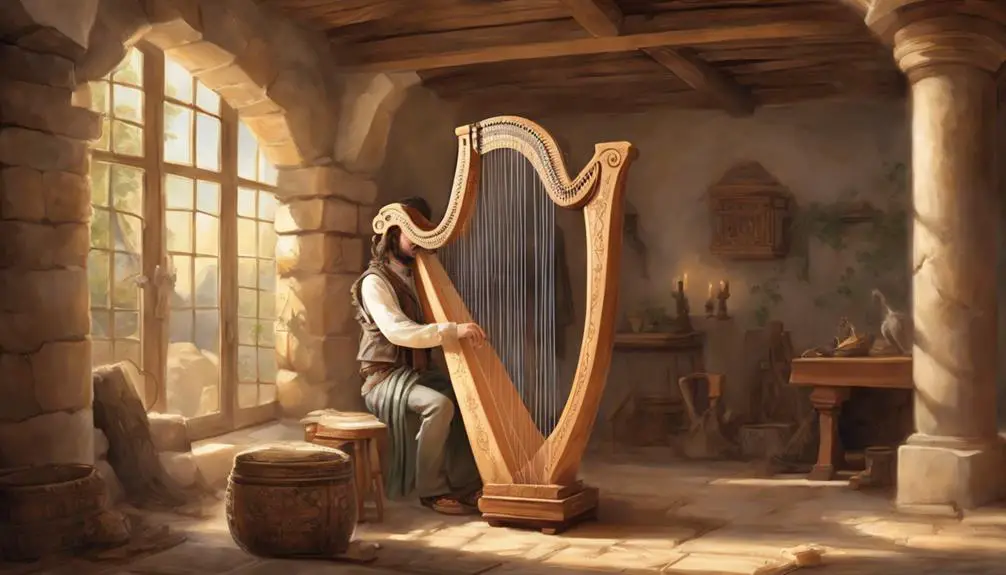
Turning our attention to the Nevel, we encounter another instrumental cornerstone in biblical music history, distinguished by its unique contributions to the soundscape of the era. Unlike other stringed instruments mentioned in biblical texts, the Nevel holds a peculiar place due to its construction and historical significance.
Here are four key aspects to consider:
- Nevel Construction: Traditionally, the Nevel was crafted from wood, with strings that varied in number from three to twelve. This variability in strings allowed for a range of sounds, distinguishing it from other harps of its time. The crafting required meticulous attention to detail, ensuring the Nevel produced a resonant, melodic tone.
- Historical Significance: The Nevel was more than just a musical instrument; it was a conduit for spiritual expression. Its use in religious ceremonies and events underscored its integral role in connecting the divine with the earthly.
- Cultural Context: The Nevel's presence in biblical narratives illustrates its importance in ancient Israelite culture. It wasn't merely an object of entertainment but a sacred tool used in worship and royal courts.
- Symbolic Representation: Beyond its physical attributes, the Nevel symbolized harmony and beauty. Its sounds were considered heavenly, further elevating its status within the spiritual and cultural domains of the time.
Understanding the Nevel's construction and historical significance offers insight into its revered position in biblical times. It wasn't just an instrument; it was a vital part of the cultural and spiritual fabric, reflecting the deep connection between music, worship, and community life.
Hand Drums in Sacred Ceremonies
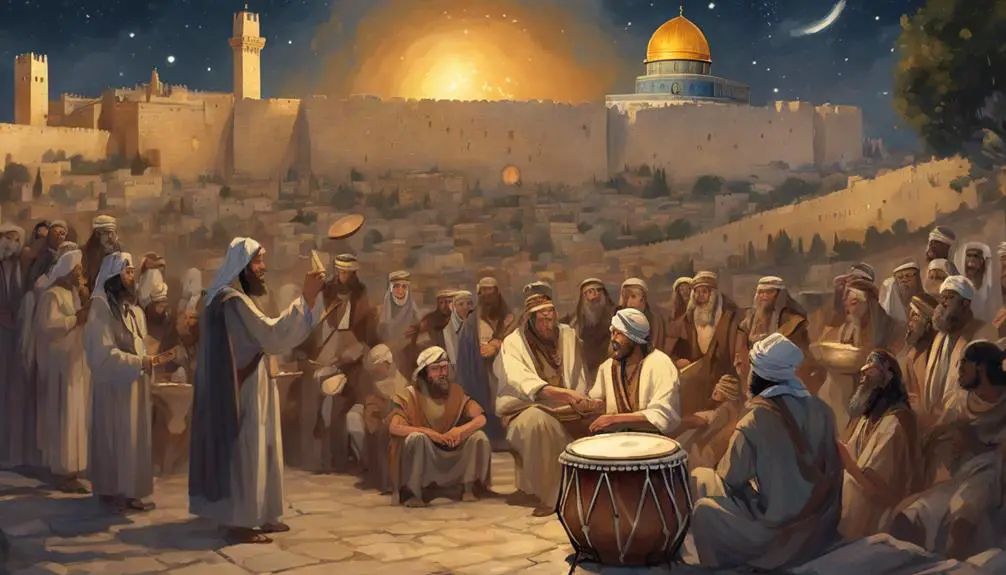
Delving into the realm of sacred ceremonies, hand drums emerge as pivotal instruments that not only provided rhythm but also facilitated a deeper spiritual connection among participants. Their ritual significance spans across a wide array of cultural variations, highlighting their versatile role in enhancing the spiritual ambiance of sacred events. In analyzing the biblical context, it's evident that these instruments were integral in elevating the worship experience, creating a communal sense of unity and devotion.
The hand drum, in its simplicity, carried profound symbolic meanings. It wasn't just an instrument for musical accompaniment; it was a tool for communication with the divine. Through rhythmic patterns, worshippers could express emotions ranging from deep sorrow to exuberant joy, translating the human emotional spectrum into a language understood by the spiritual realm. This dual function—both as a musical instrument and a medium for spiritual expression—underscores the hand drum's importance in biblical times.
Cultural variations in the use of hand drums during sacred ceremonies further attest to their universal appeal and adaptability. Whether in solemn gatherings or jubilant celebrations, the hand drum transcended geographical and cultural boundaries, adapting to the specific needs and traditions of each community. Its presence in numerous biblical accounts reveals its indispensability in fostering a communal spirit and enhancing the worship experience.
In summation, the hand drum's role in sacred ceremonies was multifaceted, serving not only as a source of rhythm but also as a bridge connecting the earthly with the divine. Its widespread use across different cultures underscores the universal human desire to seek spiritual connection through music.
The Shofar: Calls to Worship
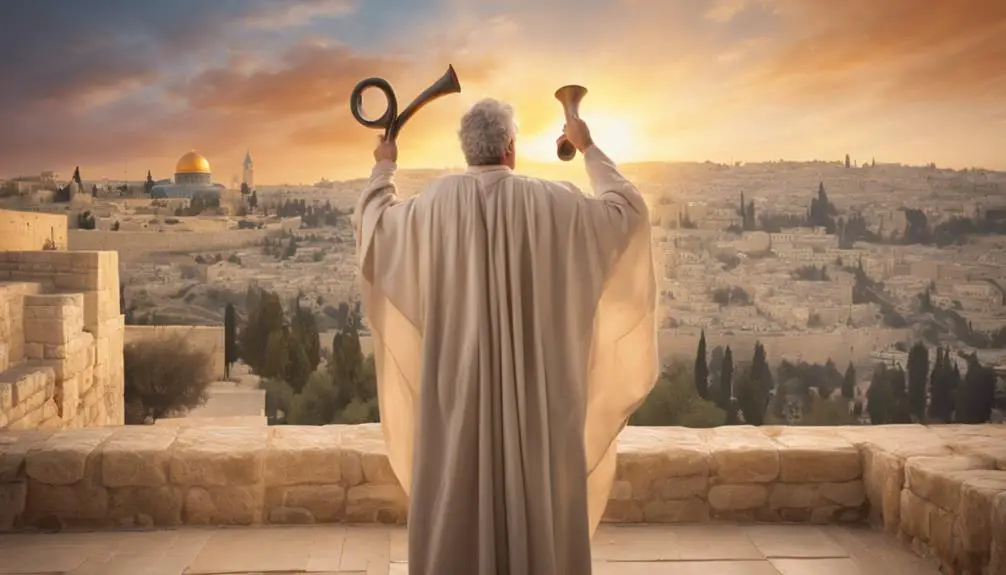
Among the myriad of instruments mentioned in the Bible, the shofar stands out for its profound role in signaling calls to worship and marking significant religious events. You might already be familiar with the image of this horn, but let's delve deeper into its origins and ceremonial uses, shedding light on why it held such an indispensable place in biblical times.
- Shofar Origins: The shofar is traditionally made from a ram's horn, symbolizing the ram provided by God in place of Isaac during Abraham's test of faith. This deep historical and spiritual significance roots the shofar firmly in Jewish culture and religious practices.
- Ceremonial Uses: Its uses extend far beyond simple musical accompaniment. The shofar's blasts were intricately woven into the fabric of ancient Israelite society, serving several ceremonial purposes:
- Announcing the beginning of the Sabbath and holidays
- Calling the community to assembly
- Signaling the start of a battle
- Proclaiming the coronation of a new king
These functions illustrate the shofar's versatility and its central role in the religious and social life of the people.
- Symbol of Repentance: During the High Holy Days, especially on Yom Kippur, the shofar's cry serves as a powerful call to repentance and spiritual awakening, reminding the faithful of their covenant with God.
- Apocalyptic Significance: In prophetic texts, the sound of the shofar heralds significant eschatological events, underscoring its role in both temporal and eternal dimensions of faith.
Understanding the shofar's origins and multifaceted ceremonial uses enriches our appreciation of its enduring legacy in worship practices, illustrating its unique position among biblical instruments.
Cymbals for Joyful Celebrations
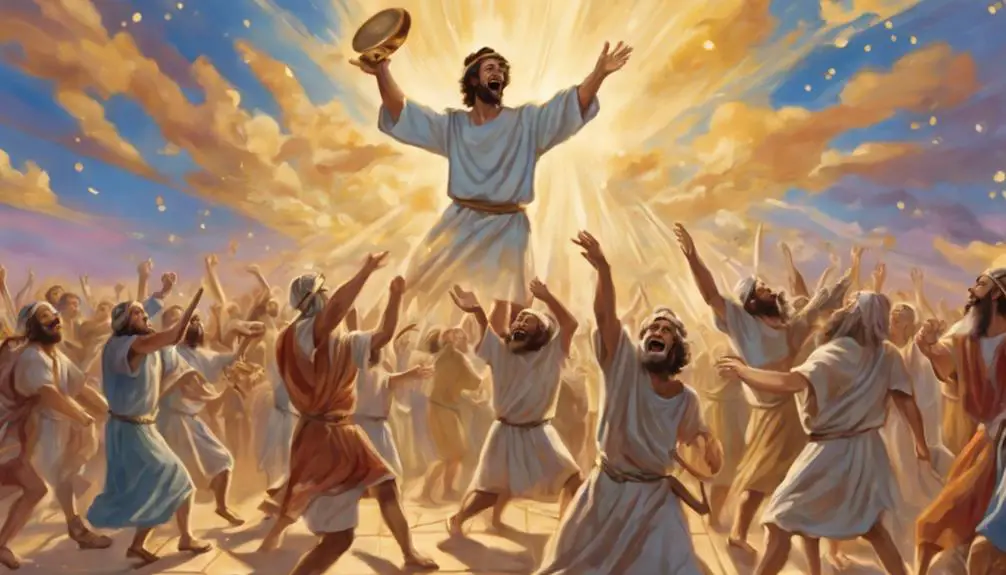
Cymbals, often clashing in jubilant celebration, held a distinctive place in biblical festivities, symbolizing joy and divine presence in moments of communal gathering. Their role wasn't just musical but deeply ceremonial, intertwining with the fabric of spiritual life and worship. The cymbal crafting techniques of the time were sophisticated, involving meticulous metalworking skills to produce instruments capable of a wide range of sounds, from soft whispers to thunderous crashes. This versatility made cymbals an indispensable part of religious ceremonies and celebrations.
Delving deeper into ceremonial cymbal uses, it's clear they were more than mere instruments; they served as vessels for expressing communal joy and divine worship. When you examine passages describing King David's time, cymbals were prominently featured in processions, temple services, and victory celebrations. Their sound was a call to attention, a signal that something momentous was happening, and a reminder of the presence of the divine in the midst of the people.
The craftsmanship involved in producing these cymbals was a sacred art, with techniques passed down through generations. Each cymbal wasn't only a musical instrument but a symbol of the skill and devotion of its maker. The materials chosen, the method of forging, and the final tuning all contributed to the cymbal's ability to evoke a sense of joy and spiritual upliftment during celebrations.
Frequently Asked Questions
Did David's Ability to Play Instruments Have Any Impact on His Leadership and Kingship in Biblical Narratives?
Yes, David's musical talents significantly influenced his leadership and kingship.
By playing instruments, he showcased a unique blend of leadership styles, intertwining traditional authority with charismatic authority. This ability not only soothed Saul but also endeared him to the people, enhancing his reputation.
His musical skills, therefore, were more than an artistic endeavor; they were integral to his leadership, helping to cement his legacy as a beloved and effective king.
Are There Any Modern Musical Instruments That Can Be Directly Traced Back to the Ones David Played in the Bible?
You're diving into instrument evolution, discovering how ancient sounds shape today's music. Modern adaptations of biblical-era instruments, like the harp David played, show a direct lineage in design and function.
These adaptations aren't just replicas; they're evolved forms, integrated into contemporary genres. Analyzing these connections offers a scholarly glimpse into how ancient music influences modern compositions, blending historical context with today's musical landscape.
It's a fascinating journey through musical archaeology.
How Did David's Musical Talents Influence His Relationship With King Saul, According to Biblical Accounts?
In the biblical narrative, David's musical talents were like a soothing balm to King Saul's troubled soul. Initially, Saul found solace in David's melodies, elevating him to a therapeutic role within the royal court.
However, as David's fame and favor grew, Saul's appreciation turned to envy. This shift highlights a complex dynamic where David's gift, meant to heal, inadvertently sowed the seeds of Saul's jealousy, altering their relationship fundamentally.
In Addition to Playing Instruments, Is There Evidence in the Bible of David Composing Music or Lyrics for Worship?
Yes, beyond his instrumental talents, David's significant contribution to worship music is evident through his compositions.
Many Psalms are attributed to him, showcasing David's poetry and deep spirituality.
These works are foundational to worship origins in Judeo-Christian traditions, reflecting his ability to capture complex emotions and divine praise.
His lyrical prowess not only complements his musical skills but also cements his legacy as a key figure in developing worship practices.
How Has David's Use of Musical Instruments Been Interpreted or Symbolized in Christian and Jewish Traditions Over the Centuries?
In Christian and Jewish traditions, David's use of musical instruments has been rich in symbolism and cultural interpretations. Surprisingly, over 150 references to music exist in the Bible, highlighting its importance.
David's musicianship, notably his harp playing, symbolizes divine connection and spiritual solace. This musical symbolism extends to worship practices today, where instruments often represent voices of prayer and reflection.
Analyzing these traditions offers deep insights into the enduring legacy of biblical music.
Conclusion
In sum, David's musical talents weren't limited to just strumming his iconic harp; he was a virtuoso of ancient instruments, from lyres to hand drums. Even the archaic nevel found its place among his repertoire, blending with the spiritual cadence of shofars and the jubilant clash of cymbals.
Imagine him as the biblical equivalent of a rock star, his music echoing through the corridors of time. This diverse instrumentation underscores the multifaceted nature of worship and celebration in ancient Israel, reflecting a rich cultural tapestry.


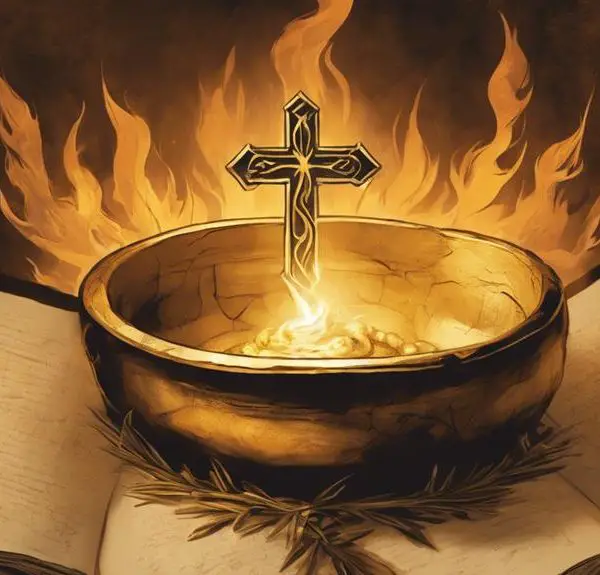
Sign up